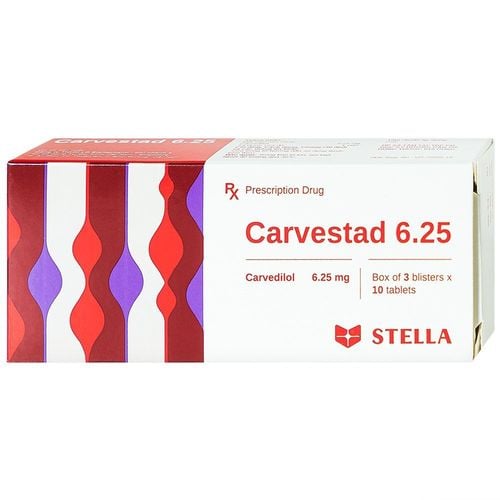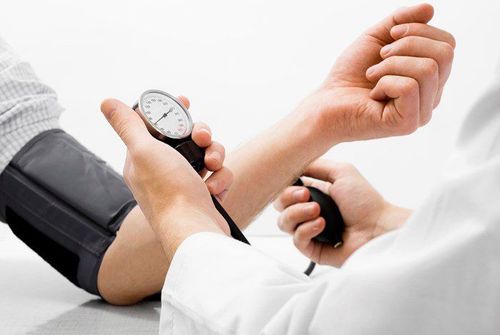This is an automatically translated article.
Amlaxopin belongs to the group of cardiovascular drugs, with the main effect used to treat hypertension and cardiovascular diseases. Adhering to the indications, the dose of Amlaxopin will help patients improve the effectiveness of treatment and avoid unwanted side effects.
1. What is Amlaxopin?
Amlaxopin has the main active ingredient Amlodipine and other excipients just enough. The drug is prepared in two forms, Amlaxopin 5mg and Amlaxopin 10mg. Both are prepared for users in the form of tablets, packaged in 3 blisters, each blister x 10 tablets.
2. Amlaxopin drug use
Mechanism of action: Active ingredient Amlodipine has the effect of blocking calcium channels in the body, affecting the movement of calcium into heart cells and blood vessels. Therefore, the drug will relax the blood vessels and provide better blood and oxygen to the heart, helping the heart to rest and good for the nervous system.
Amlaxopin has therapeutic effects:
Helps control unfounded high blood pressure; Treatment of patients with stable angina; Treatment of angina pectoris due to vasoconstriction. Contraindications of Amlaxopin include:
People with hypersensitivity to Amlodipine active ingredient or any ingredient in the drug. People with diseases such as: low blood pressure, cardiogenic shock, heart failure after myocardial infarction and aortic stenosis. Note: Cases of contraindications should be understood as absolute contraindications, not for any reason that they should be flexible to use the drug.
3. Dosage and how to take Amlaxopin
How to use: Amlaxopin is prepared in the form of tablets, to be taken orally with or without food. It is recommended that patients take Amlaxopin with a sufficient amount of water, along with filtered water, and avoid other liquids such as milk, wine and beer. When taking Amlaxopin, the patient should not break, crush or chew, to avoid affecting the effect of the drug. Patients should take Amlaxopin after meals.
Dosage: Dosage of Amlaxopin should be based on the patient's medical condition and response to treatment. Refer to the following dosage:
Used to treat angina : Use a dose of 5-10mg. Most patients will use the 10mg dose to achieve the best effect. In the elderly and in patients with hepatic impairment, the dose should be reduced. Used to treat coronary artery disease: Use dose from 5-10mg / time / day. Most patients need to use 10mg of the drug is reasonable. For the treatment of hypertension in children 6 to 17 years of age: 2.5 mg to 5 mg daily. Note: The dose per person will be adjusted according to the blood pressure goal, the treatment time can last from 7 to 14 days. If after that time there is still no effect, it is necessary to stop taking and conduct a medical examination for advice and adjustment by other methods.
In case of missed dose: The patient can take it 1 to 2 hours after the time prescribed by the doctor. However, if it is too close to the next dose, the patient should skip the missed dose and take the next dose. Never use double the prescribed dose.
In case of overdose: To date, there have been no reports of symptoms from an overdose of Amlaxopin. However, if you see unusual symptoms that are suspected to be caused by an overdose of Amlaxopin, the patient should immediately notify the doctor or medical person in charge or call 911 immediately if the symptoms are severe. Family members need to bring medical records, prescriptions that have been used and are being used so that doctors can quickly diagnose and conduct treatment.
4. Amlaxopin side effects
During the use of the drug, in addition to the main effect that Amlaxopin brings, the patient may also experience some unwanted side effects as follows:
Appearance of skin allergies, itching and rash red; Causes dizziness, headache, dizziness and drowsiness; Abdominal pain, nausea and diarrhea; Causes chest tightness, shortness of breath, symptoms of swelling and palpitations; Pale body and loss of appetite; Causes muscle and joint pain; Gum hyperplasia, gynecomastia in men, frequent urination and mood changes. If you experience these symptoms, the patient should stop using Amlaxopin and notify the doctor for appropriate treatment.
5. Amlaxopin drug interactions
Amlaxopin may have an interaction reaction if used concurrently with:
Non-steroidal anti-inflammatory drugs: May reduce the antihypertensive effect of Amlodipine. Estrogen active ingredients: When combined can create a tendency to increase blood pressure. Sympathomimetic drugs: Reduces the antihypertensive effect of Amlaxopin. To avoid interactions, before being prescribed Amlaxopin, patients should inform their doctors about all the drugs they are using, including functional foods. The doctor will base on that to prescribe the appropriate Amlaxopin.
6. Some notes when using Amlaxopin
Patients should use Amlaxopin exactly as directed by the doctor If the patient has stomach pain, they should bring food to use before taking the medicine to avoid stomach irritation. Amlaxopin should be used with caution in cases such as: The elderly, pregnant women, lactating women, children under 15 years old, people with liver failure, kidney failure, muscle weakness, kissing. liver failure and peptic ulcer disease. Above is all information about Amlaxopin, patients need to carefully read the instructions for use, consult a doctor / pharmacist before using. Note, Amlaxopin is a prescription drug, patients absolutely must not buy drugs to treat at home because they may experience unwanted side effects.













